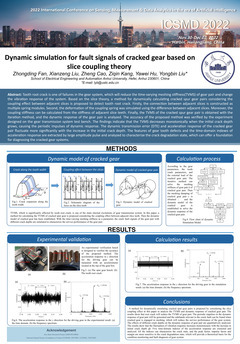报告详情
Dynamic simulation for fault signals of cracked gear based on slice coupling theory
编号:21
访问权限:公开
更新:2022-12-20 14:58:29
浏览:804次
张贴报告
摘要
Tooth root crack is one of failures in the gear system, which will reduce the time-varying meshing stiffness(TVMS) of gear pair and change the vibration response of the system. Based on the slice theory, a method for dynamically calculating cracked spur gear pairs considering the coupling effect between adjacent slices is proposed to detect tooth root crack. Firstly, the connection between adjacent slices is constructed as multiple spring modules. Second, the deformation of the coupling spring was simulated using the difference between adjacent slices. Moreover, the coupling stiffness can be calculated from the stiffness of adjacent slice teeth. Finally, the TVMS of the cracked spur gear pair is obtained with the iteration method, and the dynamic response of the gear pair is analyzed. The accuracy of the proposed method was verified by the experiment designed on the gear transmission system test bench. The findings indicate that the TVMS decreases monotonically when the initial crack depth grows, causing the periodic impulses of dynamic response. The dynamic transmission error (DTE) and acceleration response of the cracked gear pair fluctuate more significantly with the increase in the initial crack depth. The features of gear tooth defects and the time-domain indexes of acceleration response are extracted by large amplitude pulse and analyzed to characterize the crack degradation state, which can offer a foundation for diagnosing the cracked gear systems.
关键词
Time-varying meshing stiffness;Tooth root cracks;Slice coupling;Slice theory;Time-domain indexes
报告人

Fan Zhongding
AnHui University全部评论
重要日期
-
会议日期
11月30日
2022
至12月02日
2022
-
11月30日 2022
初稿截稿日期
-
12月24日 2022
报告提交截止日期
-
04月13日 2023
注册截止日期
主办单位
Harbin Insititute of Technology
China Instrument and Control Society
Heilongjiang Instrument and Control Society
Chinese Institute of Electronics
IEEE I&M Society Harbin Chapter
China Instrument and Control Society
Heilongjiang Instrument and Control Society
Chinese Institute of Electronics
IEEE I&M Society Harbin Chapter
联系方式
- Organizing Committee
- ic******@163.com
历届会议
-
2025年11月21日 中国 Guangzhou
2025 International Conference on Sensing, Measurement & Data Analytics in the era of Artificial Intelligence -
2023年11月02日 中国 China
International Conference on Sensing, Measurement & Data Analytics in the era of Artificial Intelligence -
2023年11月02日 中国 Xi'an
2023 International Conference on Sensing, Measurement & Data Analytics in the era of Artificial Intelligence -
2021年10月21日 中国 Nanjing
2021 International Conference on Sensing, Measurement and Data Analytics in the era of Artificial Intelligence -
2020年10月15日 中国 Xi'an
International Conference on Sensing, Measurement and Data Analytics in the era of Artificial Intelligence



发表评论